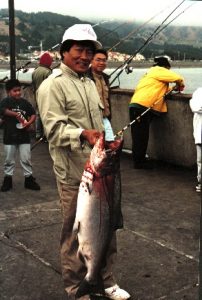
King salmon — 1998
You’ve set out your bait and are waiting for a fish. What’s next or what’s the best approach. A PFIC regular gave some clues: Posted by Calrat, June 30, 2004 — When a salmon bites on the classic Pacifica Trolley rig, I set my drag loose to a point where it can run but not too far. The bobber can go down but usually what happens is you’ll see it flying off into some direction. (That’s if you’re watching the bobber) You’ll also notice your rod jerking around… There are so many people out there, when a fish is on, usually the regulars will just start yelling a color of the bobber going this way and that way. As aggressive an environment as it may seem, the Pacifica Pier fishermen help each other out by keeping an eye out on everybody else’s line. If you plan to go out this weekend, AND I THINK YOU’RE NUTS, then good luck. You shouldn’t have any problems knowing if a fish is on… If you’re an honest fisherman, and I hope you are, you’ll be using a circle hook with no barbs (as per the guidelines of the DFG). The fish will take your bait and set itself. MAKE SURE YOU DON’T GIVE ANY SLACK EVER DURING THE FIGHT WHEN USING THE CIRCLE HOOK OR IT WILL COME OFF! If you’re a crooked fisherman, and you’re using a regular hook with barbs, set it when the fish is on even though it’s probably set already… that is, just to make sure you have him on good. It’s much like a small bat ray fight
Sometimes the salmon come in closer to shore and the anglers mid-pier will use a shortened trolley rig. If baitfish is present, they’re usually being caught and that’s when the anglers will switch to live bait: a live anchovy or sardine instead of a “popsicle.”
A necessary piece of equipment is a hoop net to bring the large fish up onto the pier. Although most Pacifica salmon will weigh 6-12 pounds, fish over 20 pounds are common, and 30 pounders are seen fairly often. The record appears to be a 51-pound monster that was caught the last week of July 2002.
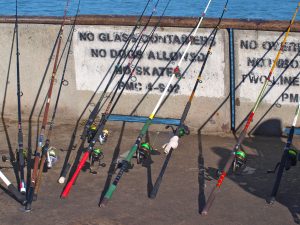
Crabbing rods during the Dungeness season
What probably should be considered an essential piece of equipment are the dual purpose special “Pacifica rod holders” available at local bait shops (and sometimes from people on the pier). It’s a welded rod-holder specifically made to fit the pier’s railing. Dual purpose? To hold the rod and to claim the territory.
Do make sure you know what you are doing if you decide to join the fray when the salmon “are in.” The fishing is serious business to the throngs who invade the pier during the salmon invasion and fools are not suffered lightly. Using improper sinkers that don’t hold bottom (resulting in tangled lines), failure to get out of the way of a hooked fish, or barging into someone’s space can result in things like cut lines and threats. It’s elbow-to-elbow fishing that the more caustic liken to a “combat zone” and be alert if you hear someone yelling “headache” while making an illegal overhead cast.
Read up, ask questions, bring the right equipment, and know what to do when you head out to the pier. You can usually also get some advice from the locals but it will depend upon your already existing knowledge, your willingness to listen, and a little bit of common sense.
In all the years I fished Pacifica I never had a problem but Î have heard stories of some that have. By the way, an early arrival is always good. Depending upon the tide there may only be a small contingent of anglers when you arrive, thus assuring yourself of a good spot. As high tide approaches the numbers start to increase and sometimes they can jump up to 200-300 people. Soon there’s a crowded railing (and three inches of railing space next to you can be considered a free spot). But, it’s probably better for them to barge into your space than for you to barge into their space (not fair but better).
One problem that has increased over the years is sea lions, when the salmon show up the sea dogs will not be far behind. Some days may see as many as a third of the salmon ambushed before they reach the nets that have been lowered into the water.
Crabbing Tips. Two types of tackle are used by those seeking out the tasty crustaceans on the pier, the normal old-fashioned crab (hoop) nets and the increasingly more common crab snares. Crabbers seem divided as to what to use and each has its pluses and minuses.
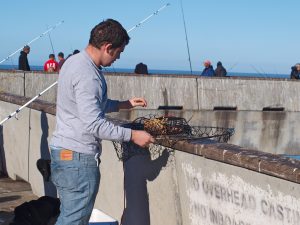
Crab (Hoop) net
The main plus for crab nets is that they don’t require much additional equipment other than the crab nets and goodies that come with them (rope and bait box). There are a couple of negatives for their use at Pacifica: (a) Though they work well during mild conditions the gigantic waves at Pacifica can render the nets almost useless at times and make it hard to keep the nets away from the pilings. Many hoop nets are lost to snags and the loss is costly. (b) Sea lions have learned to search out food in the hoop nets and reports of tug-of-war contest between crabbers and sea dogs are common. Usually the sea lion wins.
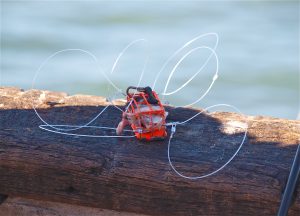
Crab snare
The pluses for crab snares are that they have proven to be effective and they reduce the chance of losing gear. In addition, fairly inexpensive snares can be purchased at local bait shops. In addition, a few entrepreneurial souls make and sell their own snares on the pier (at an even less expensive price). Those people are on the piers most weekends and at least one includes a sinker and a shock-leader with his snares. But snares too have negatives, the main being the need to have an additional item —a fairly heavy rod and a strong saltwater reel to cast out the snare along with sufficient line (30 pound plus).
How do you tell when a crab hits a snare? PFIC regular dsmiths supplies an answer: “It seems to be typically a long, slow pull followed by a quick sometimes jerky release. You can tell the difference between this and wave action because the waves will move slowly in both directions.”
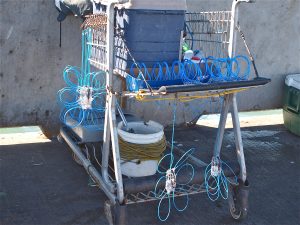
The best bait for both hoop net and crab snare, as always, is squid with sardine, squid with anchovy, and squid with mackerel. The fish supply the oily and/or bloody scent while the squid are tough and survive attack. Use chicken and your gear may be pulled apart by sea lions. Why the pinnipeds favor chicken over fish, no one seems to know but fewer are using it (even though it was once considered the “bait de jour.”
Whatever the tackle it’s common most days to take at least a few keeper-size crabs from Pacifica and some days will yield limits of the tasty crustaceans.
Just like their cousin “lobster poachers” to the south, “Dungee poachers” can also be a problem at the pier. They like to show up at night armed with multiple snares and a proclivity to keep Dungeness that are out of season, as well as crabs that are too small.
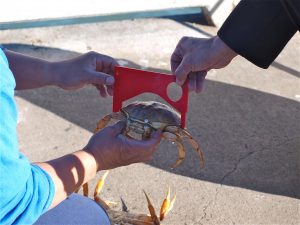
The right way to do it
Fish and crabs at Pacifica, an interesting overlook with some interesting observations, some good and some not so good. But, as one angler mentioned to me, what other California pier allows you a chance to catch both salmon and crabs on the same day, a veritable potpourri of gastronomic delicacies. Makes you kind of want to take along a tablecloth, a bottle of white wine, and some sourdough bread. Of course I’m not too sure where you would stage this Epicurean feast; when fishing is good the pier can be crowded, dirty and, in blunt terms, smelly. Dried blood, bullhead slime, sun-ripened bait, angler urine and sea gull droppings do not exactly lend the proper ambiance for a picnic. I once suggested to my daughter that her wedding would be fairly unique if it took place alfresco, out at the end of the Pacifica Pier. She said, in no uncertain terms, NO THANK YOU and gave me that stare. That was the end of that conversation.
Potpourri — Perhaps more than you may want to know about the Pacifica Pier
<*}}}}}}}}}><— Fish surveys done by the California Department of Fish and Game for the years 2004-2009 show a mix of 27 species of fish at the pier. The species (listed numerically) — white croaker, shiner perch, walleye surfperch, jacksmelt, silver surfperch, northern anchovy, Pacific sanddab, white seaperch, striped seaperch, Pacific sardine, barred surfperch, sharpnose seaperch, Pacific tomcod, Chinook (king) salmon, kelp greenling, striped bass, spotfin surfperch, rainbow seaperch, pileperch, calico surfperch, redtail surfperch, black perch, rainbow trout (steelhead), starry flounder, sand sole, brown rockfish and leopard shark.
The numbers, as expected, are dominated by the schooling species—perch (shiner, walleye, silver, white, striped and barred), top-water species—jacksmelt and northern anchovy, and two bottom species—white croaker and Pacific sanddab. Striped bass were recorded five out of the six years while the king salmon were counted only one year, 2004. Surprising to me were the fairly high number of striped seaperch (recorded four years) and sharpnose seaperch (recorded two years). Very surprising to me was the low number of calico and redtail surfperch that were recorded (both only recorded for one year) and the absence of any staghorn sculpin (that have always been among the most common fish at the pier). It’s simply hard to explain some of the numbers.
<*}}}}}}}}}><— How dumb it this?
Pacifica Pier Vandalism — The vandals who pried up concrete benches from the Pacifica Pier and possibly tossed them over the side into the ocean cost the city nearly $6,000. That’s the estimated cost to replace the benches, which were discovered missing July 20. The culprits also pried up a steel plate from the floor of the pier.
Police Beat, Pacifica Tribune, August 1, 2007
<*}}}}}}}}}>< — Most piers seem to appear in a movie sooner or later. The Pacific Pier was seen in the 2003 film “House of Sand and Fog.”
<*}}}}}}}}}>< — Although the following fish wasn’t caught by hook or line it was found by the pier and could have been caught—right?
In the category of the weird, slimy and mysterious, a denizen of the deep washed up — still writhing, mind you — on the beach near the pier. The fish, which was over four-feet long, was identified as a longnose lancetfish, which the Peterson field guide describes as a toothy (named for its lancet-like teeth) scaleless, voracious deep-water predator with a dorsal fin like a sailfish who also happens to be a hermaphrodite. The fate of the critter, who occasionally washes up on beaches for no apparent reason? A picture was hastily taken before it found its way into a crab net to be used as bait. So much for science.
—Brian Hoffman, The Fishing Report, San Francisco Chronicle, June 13, 1996
<*}}}}}}}}}><— A short distance down the shoreline from the pier is Laguna Salada, a freshwater lagoon and marsh area fed by Sanchez Creek, a creek that serves as a tributary of the larger San Pedro Creek.
Records show that the water in the creeks was once home to steelhead and silver salmon. A 1912 letter indicates San Pedro Creek was stocked and over the years it was noted that steelhead spawned in the creek. In 1968 the California Department of Fish and Game reported there were about 100 steelhead in San Pedro Creek and that the steelhead resource was both viable and important. However, it also reported that continued sedimentation, the construction of culverts, water diversion, and urbanization was affecting spawning habitat and leaving “the long-term survival of the steelhead resources in question.”
Urbanization of Laguna Salada itself dates in large part to 1931 when the City of San Francisco built the Sharp Park Golf Course golf course over the wetlands (and eventually a seawall was built to protect the area). This has led to considerable debate and lawsuits. The lagoon area is home to two endangered species—the California Red-Legged Frog and the San Francisco Garter Snake, and a “Save The Sharp Park Wetlands!” movement emerged. People want the area restored, want the seawall removed, want the golf course removed, and would like to have the land turned over to the National Park Service to become part of the Golden Gate National Recreation Area. To date, San Francisco has refused. It’s unclear if the steps mentioned would result in a return of the steelhead and silver salmon.
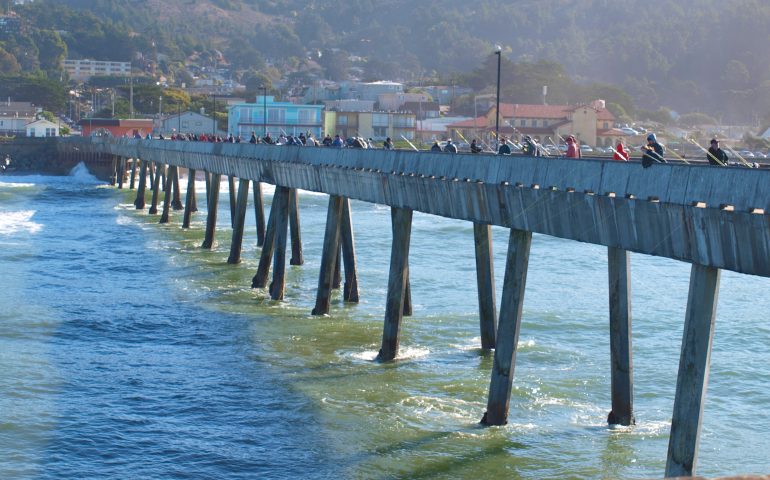
One of the best fishing pier. Got a lot salmon, stripers, perch on this pier. Go there early.
So is it safe to eat the kingfish?
In general, open-ocean areas like Pacifica have perfectly safe and delicious kingfish populations. We fished there in June and caught several large kingfish (among 9 species of fish and crabs caught) that were clean, healthy, and free of the commonly found small worms.
I enjoyed your description of fishing at Pacifica Pier and the pictures. Well done. Very interesting with lots of information.
great commentary on fishig the pier. thank you.
Would you know the length of rope needed for crabbing off of the Pacifica Pier, CA.?
jesse r king i had 100ft of rope last time i went and it was plenty.
Hi! I love this website.
A lot of people say squid on a Sabiki does not work on a sabiki, but
when I was fishing at oyster point peir I hooked an 18 – inch jacksmelt.
My girlfriend and I went to Pacifica Pier on April 3, 2021. We didn’t see a lot of people on the pier. We walked along the pier and stopped just short of the end before turning around and heading back. We did see a man bringing in his catch of the day through using a small boat he pulled up on the beach. We continued our walk just beyond the beginning of pier and eventually headed back to the car.
After the superficial damAge this past January The city closed the entire pier and was debating weather to close the pier permanently. They refused my calls to partially open it claiming it could collapse even though no expert said that.
And they refused to repair it. So I got the California Coastal Commission (CCC) involved around March 15 2021 who said the city can’t deprive the public of access without a permit from them. They immediately had the city partially open it and are now overseeing the city’s repairs which are moving very slowly because the city is crying poor even though the want to spend 12 million dollars on a new city hall.
Good to know that the CCC has jurisdiction over the piers
Thank you for your efforts on the pier.
The pier is in disrepair. The end is blocked off and is falling apart. Sad.. needs restoration!!
Started fishing here in 1985 I was 5 saw many things on that pier and in the water. A Great white shark swimming under the pier. Caught thresher sharks, hooked and lost blue sharks, caught salmon, and stripers, saw 40 pounder king salmon getting caught there. Old Cecil selling his undersized anchovies at international point. Watching mute Ron cast the 8 oz pyramid on international point father than anyone I’ve seen. Caught small shiners, pompano, smelt, king fish (croaker) jigged for sardines and anchovies, caught dungeness, red and rock crabs, countless bullheads piled up on the corners because nobody wanted them but great as striper bait in the carquinez! Halibut, I seen one giant sea bass caught. Seen many salmon stolen by sea lions while the og fisherman tried to hand line them in the pier when the crab net was too slow to be dropped to scoop up the fish. Pulled many bobbers and fish from the pickings during the 95 salmon run when nobody cared to retrieve there set ups. Many memories. Lots of bbgs, fights, and card playing (Pusoy) seeing bud drunk as hell but finding a way to still catch fish. Many familiar faces but never really knew names. Rudy and his son marcel. The ogs on that pier I thank my father Arnulfo Sarmiento for teaching me how to fish me and my brother Joshua. It’s sad that the pier doesn’t have the salmon fishermen anymore and now it’s just the crab snaring crowd but I don’t hate I know the salmon are there but nobody try’s because nobody knows how to fish the top and the bottom of that water for them anymore. It is the best fishing pier in California and maybe one of the best in The U.s.a
Paul, Thanks for the report. I spent many a day there back in the mid to late ’70s when I lived in the Bay Area. Later, after moving north, there were far less visits but it’s still a favorite pier to visit when I am in the area. Ken
For Paul Sarmiento… a bit of instruction on how to catch Salmon off the pier would be appreiated.
In a fairly suburban area like we live in….Pacifica still has a great getaway Beach feel to it.
As I slide into my 80’s, my wife and I still like to to walk Pacifica and I always learn something
every time I fish; even to walk the pier and ask “what’s running”.